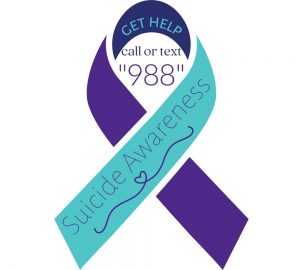Suicide Awareness and Why Kindness is Key

According to The Centers for Disease Control and Prevention, the U.S. suicide rate is at the highest it has ever been, with almost 50,000 Americans taking their own lives documented in 2022. Experts explain why a centuries-long epidemic is getting worse.
Suicide has been a devastating epidemic in society that demonstrates no sign of losing momentum. The stigma surrounding mental health disorders often prevents people from seeking help, telling their loved ones how they are feeling or even just openly talking about their emotions.
While there are many different factors that could cause suicidal ideation within a person—and they are unique to each individual’s experience—local resources provide methods of help for those in need. And for those who hesitate to speak up, professionals provide valuable, universal advice for how the community can destigmatize mental unwellness by practicing kindness and empathy. After all, a loved one could be silently suffering until it’s too late.
“[The community] can learn more about mental health issues in general,” says Cheryl Molyneaux, Peer Support Coalition of Florida’s executive director. “They could learn more about simple human kindness, such as taking the time to check in on people and … say, ‘How are you doing?’ and actually wait for the answer and respond to it. Right now, ‘How are you doing?’ is the same as ‘Hello:’ You say it, and you keep moving. So, the community would be helpful in just listening, just showing that they care about somebody else who may be struggling.”
People should not have to be on the brink of suicide for their suffering to be taken seriously; they need help before reaching that extreme. Spreading awareness and working toward suicide prevention includes seeking treatment even in the earliest stages of suicidal thoughts. It might be difficult to recognize the signs of those who are keeping their pain a secret, but some behavioral changes to look for are loss of interest, substance abuse, drastic mood differences and abnormal sleep patterns. These indications differ depending on each individual’s age and demographic, but negative changes of any kind are a signal to check on the person who is experiencing them.
Suicidal ideation may also stem from a previous disorder or traumatic event, such as depression or grief—it is not unique to any particular circumstance. Startlingly, a person intending a suicide attempt will typically hide any signs of it because they do not want to be stopped. That is why, if it is known that someone has been through something, it’s important to check in—even if they appear to be OK on a surface level.
“We have a program … called Emotional CPR, and it’s a public health initiative that helps people, anyone, to help someone else who is experiencing strong emotion in a crisis, just simply needing support,” Molyneaux says. “And one of the tenets of that is to simply listen, and ask, and share with the person so you’re providing a space for them to explore what they’re feeling and just come to whatever conclusion they’re going to come to in the safety of your support for that. And that’s the only thing that I think really, truly helps, is just expressing, ‘How may I help you? Is there something happening right now that you would like to talk about?’”

Although suicide is documented throughout centuries, current generations face the additional challenges of navigating the internet. Unfortunately, social media and cyberbullying are in the headlines as a contemporary instigating factor of young people taking their own lives. This also correlates with a child at risk of self-harm being less inclined to share their internet activity with trusted adults. It can be terrifying from a child’s perspective to think that something on the internet will stick with them for life and negatively affect their future: In that panic, suicide might seem like the only solution, as everything seems much more dire at a younger age. It is important to educate children about internet safety, to assure them that no matter what hardships arise, that it is not the end of the world—and most importantly, to teach them not to be cruel to others. Behind a screen, children might think that there are not any consequences to their words or behavior. This is why empathy and humanity are essential in saving an at-risk individual’s life.
Another modern trend in suicide rates is that of transgender students, according to a Johns Hopkins report, “Going Deep Into the Why of Suicide,” published in May of this year. This is due to the recent rise in persecution toward members of the LGBTQIA+ community, in culmination with their own internalized perception of identity and sexuality during their developmental stages. The report recommends an increase in gay-straight alliance clubs at schools, as well as educating students about LGBTQIA+ safe-space resources, such as The Trevor Project for those in crisis. Marni Stahlman, president and CEO of the Mental Health Association of Central Florida, references these statistics.
“You have to look at not just bullying,” she says. “You have to look at the identification of some specific ethnicities, and certainly, the issues about gender and sexuality that have risen and been identified across the country now within the LGBTQ+ community. They’re significantly singled out as an identified group that seems to have a higher level of prejudice perpetrated against them than we’ve seen in decades.”
An additional Johns Hopkins report in July evidenced through CDC data that the amount of suicide completions with a gun are at an all-time high, stating that guns are the leading cause of death among children and teenagers. Furthermore, the suicide rates of Black children and teens have tripled in the past 20 years: 2022 is the first time it was reported that the Black community has the highest gun suicide statistic. Any person can be at risk, but the implement of programs and compassion for the most at-risk members of society may be the key to suicide prevention. Resources should be available to any person regardless of background or income—and having those support systems in schools is a great starting point.
“Here in Florida, after the Marjory Stoneman Douglas shooting that took place in South Florida, a commission was formed to exactly look at that—and one of the outcomes that was put into place that was mandated in this past year before the new school year starts … [was that] 85% of the school districts in the state of Florida had to show that their employees had been trained in something called Mental Health First Aid, which is a curriculum for staff administration and employees of the district,” Stahlman says.
Ultimately, having more open discussions today about mental health helps to diminish that stigma. Especially since COVID, and with the positive implementation of internet resources, people are connecting with each other and realizing, perhaps for the first time, that they are not alone. However, there is still work to be done. There is indeed hope for change, but continuing to spread awareness and taking the time to be present for a person in need will go a long way in providing for a brighter future.
Resources:
| Mental Health Association of Central Florida Orlando (407) 898-0110 MHACF.org |
Peer Support Coalition of Florida Seminole County (407) 340-6332 PeerSupportFL.org |






